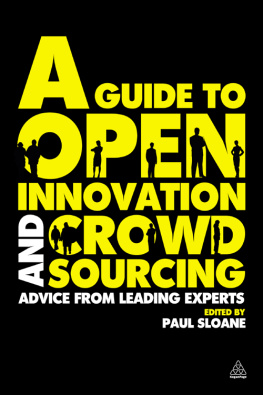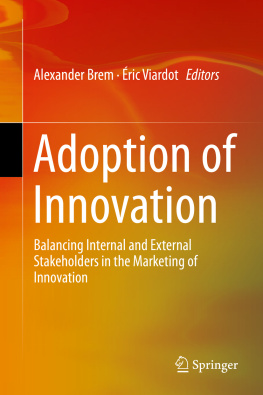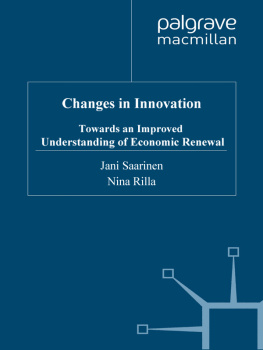Jenny S. Z. Eriksson Lundstrm , Mikael Wiberg , Stefan Hrastinski , Mats Edenius and Pr J. gerfalk (eds.) Managing Open Innovation Technologies 2013 10.1007/978-3-642-31650-0 Springer-Verlag Berlin Heidelberg 2013
Managing Open Innovation Technologies
The objectives of this book are to advance and disseminate research on systematic practical open innovation, and make research results available to practitioners. The intended target audience is both international academic community and industry community partners, including civil society.
In particular, with the book we aim to
Motivate and analyse the benefits of open innovation
Present challenges in adopting open innovation technologies
Capture best practices in the management of open innovation technologies
Offer experiences from real-life open innovation projects
Topics addressed in this book include:
Open innovation as in use todaytheoretical underpinnings and lessons from related research fields
Analysis of the use of open innovation in organisations today in order to extract best practices
Forward-looking theoretical as well as practical future use of open innovation
The chapters address the particular topics by experiences/results gained in real-life projects and/or other empirical research. Each chapter clearly states its purpose and how readers are supposed to benefit from it by means of experience reports and easy-to-grasp practical advice.
Jenny Eriksson Lundstrm
Mikael Wiberg
Stefan Hrastinski
Mats Edenius
Pr J. gerfalk
Managing Open Innovation TechnologiesContemporary Best Practices
Precursors
In addressing how to successfully manage open innovation and open innovation technologies we first need to define what we mean with innovation and open. While invention is the first occurrence of an idea that changes thinking, things, processes or services (McKeown 2008), innovation means an invention that was implemented and taken to market (Brown 2006). Hence, in our view, innovation means enabling an increase in value for producer and/or consumer. Such enabling may come in the form of new offerings such as new or improved products or services; new processes of how products or services are created; new business models, or via changes in structuring the organisation or its value chain.
Usually the incentives of open innovation are the limitations inherent in the closed. Open means removing boundaries (Chesbrough 2003). As the world is getting more competitive, organisations find themselves in an era of innovation, distinguished by its availability of venture capital. Today, expertise is less scarce, and more people are educated. The mobility of knowledge workers, to new job opportunities outside of the organisation, means that desired knowledge and experience are more frequently available outside of the organisation than within. Locking in the best knowledge is no longer possible. Often the source of valuable offerings is to be found outside of the organisation, stemming from individuals; consumers or users who initially created value for themselves (von Hippel 2005), and refined in collaborative innovation communities to viable offerings (Baldwin et al. 2006), or via (networks of) external experts. With new technologies for communication, the transaction costs of tapping into this knowledge are decreasing, thus resulting in a shift to user-centred innovation processes, leaving traditional in-house innovation processes lagging behind.
Open Innovation and Open Innovation Technologies
Looking around the landscape of existing open innovation technologies we notice their multitude and their multifaceted nature: brainstorming, idea management, technology scouting, innovation marketplaces, prototyping sandboxes, market intelligence and test beds for innovation, just to mention a few. Not requiring high technology, innovation is still relative to the prevailing infrastructure and market maturity. Hence, IT presents itself as an enabler for both. Internet technology lends itself well to connecting large groups of customers, seamlessly interfacing with existing technology in the manufacturing line. Customer studies are bygones when direct customer interaction becomes possible, enabling learning from the customer as well as educating the customer of the offerings and the potentials of their use. Hence, at the time of internet technology and the maturity of the users, Web 2.0 applications present a great opportunity for innovation. From working hard to getting the top brains to work for us, we are instead able to tap into the vast and diversified knowledge of the world. Clearly, innovation policies are now turning from closed in-house innovation processes into open innovation ecosystems.
Managing Open Innovation Technologies
Due to the unstructured nature of these open innovation ecosystems, strategic management is the means of providing structure and direction, and hence value from the interaction. Managing open innovation technologies is about structured methods for identifying, finding, collecting and incorporating the resulting creativity and new thinking of open innovation into the existing organisations business strategy, processes or structures. Even more importantly, management deals with political, social and cultural issues that have an impact on rethinking social structures and on the mind-sets of the employees.
This means that managing open innovation technologies touches upon changes of planning, processes, people, technical infrastructure and performance. It is about finding strategies and processes of innovation and to align these to other processes of the organisation, through implementation and maintenance of current methods and tools of innovation.
Potential Issues and Challenges
Going about open innovation is never solely about theories nor best practices. It is through implementation and the use of new thinking in the existing organisation that realises the potential of open innovation. Any platform set up for collecting ideas cannot by itself transform the wisdom of the crowd into business advantage for the organisation. Additionally, the incentives and means to invest in open innovation are essential. Organisations embracing open innovation are presumed to do so for its proven ability to maintain and advance business innovation, but not all organisations that desire to adapt to customers demands are businesses or have the aim of generating profit. Drawing on open innovation is possible if management of the open innovation technology is fitted for its purpose and the organisational goals are clear. Undoubtedly, a mere reinterpretation of open innovation on to old concepts to fit the existing organisational structure or business models may cause the potential of open innovation to be left unexplored. Here lies the challenge.
Coming back to our initial story, the airport refined their understanding of the travellers solution by a root cause analysis. At a closer look, the issue was not about information boards at all, it was about the difficulty of finding the way at the airport. Clear management of any type of technology, including open innovation technologies, is the way to create value for the organisation and its customers. Doing so is all about learning the essential lessons from others, what the challenges are, to understand how this would create benefits for the organisation and push it to completion. In this book, we offer you an aggregated view of benefits and challenges of open innovation technologies, and present experiences from managing real-life open innovation projects.













